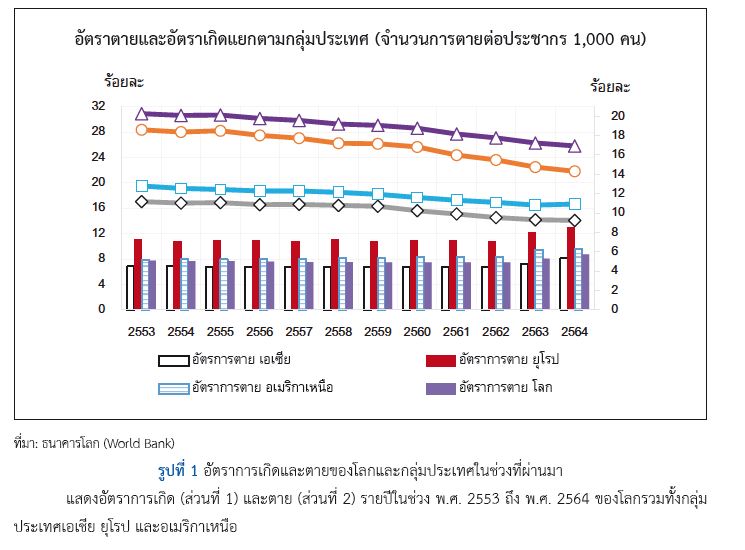An Investigation of Provincial Birth Rate in Thailand
Keywords:
birth rate; Thailand; ASEANAbstract
This study aims to 1) compare the birth rates and socio-economic factors as well as national governance factors of Thailand with other ASEAN countries, and 2) analyze the provincial socio-economic factors influencing Thailand's birth rate. The research is an empirical study using panel data from eight ASEAN countries and provincial data from 77 provinces in Thailand. The findings show that birth rates in all ASEAN countries are continuously declining, in line with global trends. Thailand has the second-lowest birth rate after Singapore, while it also has the second-highest death rate. Therefore, Thailand is likely to face a labor shortage unless the government implements clear and effective policies to address this issue. However, it was also found that national governance positively affects birth rates. Given Thailand's lower governance quality compared to Singapore, and the fact that even Singapore has not been able to implement policies to restore its birth rate to previous levels, this raises concerns about the capacity of the Thai government to manage this issue effectively. For provincial socio-economic factors influencing birth rates, it was found that population density and the number of factories per capita have a positive relationship with birth rates. In contrast, factors negatively related to birth rates include provincial per capita income, the proportion of elderly people, the proportion of female labor force, and the suicide rate. The findings of this study further enhance the understanding of population changes, offering valuable insights for policies designed to slow the decline in birth rates, which in turn affects the labor force and future national development.
References
Adelman, I. (1963). An econometric analysis of population growth. The American Economic Review, 53(3), 314–339. http://www.jstor.org/stable/1809160
Ahmed, K. J., Tan, Y., & Rudd, D. (2024). Exploring the relationship between changes in fertility and disasters: A review of the literature. Journal of Population Research, 41(1), 1-29. https://doi.org/10.1007/s12546-023-09324-9
Becker, G. S. (1960). An economic analysis of fertility. In Demographic and economic change in developed countries (National Bureau Conference Series No. 11). Princeton University Press.
Becker, G. S., & Barro, R. J. (1988). A reformulation of the economic theory of fertility. The Quarterly Journal of Economics, 103(1), 1-25. https://doi.org/10.2307/1882640
Becker, G. S. (1992). Fertility and the economy. Journal of Population Economics, 5(3), 185–201. https://doi.org/10.1007/BF00172092
Bhattacharyya, A. K. (1975). Income inequality and fertility: A comparative view. Population Studies, 29(1), 5–19. https://doi.org/10.2307/2173421
Chen, M., Atiqul, H. S. M., Ahmed, K. J., Hussain, A. H. M. B., & Quamar, A. M. N. (2021). The link between climate change, food security and fertility: The case of Bangladesh. PLOS ONE, 16(10). https://doi.org/10.1371/journal.pone.0258196
Doepke, M., Hannusch, A., Kindermann, F., & Tertilt, M. (2023). The economics of fertility: A new era. In S. Lundberg & A. Voena (Eds.), Handbook of the economics of the family (Vol. 1, Issue 1, pp. 151-254). North-Holland. https://doi.org/10.1016/bs.hefam.2023.01.003
Drakatos, C. G. (1969). The determinants of birth rate in developing countries: An econometric study of Greece. Economic Development and Cultural Change, 17(4), 596-603. https://doi.org/10.1086/450386
Easterlin, R. A., Pollak, R. A., & Wachter, M. L. (1980). Toward a more general economic model of fertility determination: Endogenous preferences and natural fertility. In Population and economic change in developing countries (pp. 81-150). National Bureau of Economic Research, Inc. University of Chicago Press.
Hajdu, T. (2024). The effect of temperature on birth rates in Europe. Population and Environment, 46(9), 1-18. https://doi.org/10.1007/s11111-024-00450-x
Haq, S. M. A., Chowdhury, M. A. F., & Ahmed, K. J., et al. (2023). Environmental quality and its impact on total fertility rate: An econometric analysis from a new perspective. BMC Public Health, 23(2397), 1-16. https://doi.org/10.1186/s12889-023-17305-z
Iwasaki, I., & Kumo, K. (2020). Determinants of regional fertility in Russia: A dynamic panel data analysis. Post-Communist Economies, 32(2), 176-214. https://doi.org/10.1080/14631377.2019.1678333
Jones, L. E., & Tertilt, M. (2008). An economic history of fertility in the U.S.: 1826-1960. In P. Rupert (Ed.), Frontiers of family economics (Vol. 1). Emerald Press.
Lal, S., Singh, R., Makun, K., Chand, N., & Khan, M. (2021). Socio-economic and demographic determinants of fertility in six selected Pacific Island countries: An empirical study. PLOS ONE, 16(9), 1-17. https://doi.org/10.1371/journal.pone.0257570
Pattarakijkusol, S., & NaRanong, A. (2021). Thailand institution factors influencing middle-income earning Generation Y's fertility intentions. Journal of Demography, 37(1), 1-25. https://doi.org/10.58837/CHULA.JDM.37.1.1
Sabermahani, A., Goudarzi, R., & Nasiri, S. (2017). Factors affecting fertility rate in Iran (Panel data 1966-2013): A survey study. Journal of Family Reproductive Health, 11(3), 138-145. https://www.ncbi.nlm.nih.gov/pmc/articles/PMC6045690/
Smuseneto, A. (2019). Determinants of childbearing among Thai-Muslim Generation Y in Thailand. Journal of Population and Social Studies, 27(4), 321–333. https://so03.tci-thaijo.org/index.php/jpss/article/view/172579
Sommer, U. (2018). Women, demography, and politics: How lower fertility rates lead to democracy. Demography, 55(2), 559-586. https://doi.org/10.1007/s13524-018-0655-x
Țarcă, V., Țarcă, E., & Luca, F.-A. (2022). The impact of the main negative socio-economic factors on female fertility. Healthcare, 10(4), 734. https://doi.org/10.3390/healthcare10040734
Weintraub, R. (1962). The birth rate and economic development: An empirical study. Econometrica, 30(4), 812-817. https://www.jstor.org/stable/1909327

Downloads
Published
How to Cite
Issue
Section
License
Copyright (c) 2024 NIDA Business School, National Institute of Development Administration

This work is licensed under a Creative Commons Attribution-NonCommercial-NoDerivatives 4.0 International License.



